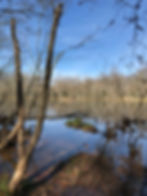Meet The Beavers
- steffney6
- May 12, 2021
- 3 min read
by Dan Crescenzo

Opinions about beavers vary widely. For many people the thought of beavers conjures up images of cute, animated animals with flat tails and big teeth. Others view them as pests that destroy trees and flood agricultural fields and forestry land, whereas others see them as integral parts of the ecosystem, promoting duck, deer, and turkey habitats. So what are beavers really, then? Pests or integral parts of the ecosystem?
The North American beaver – Castor canadensis – is a nocturnal, medium-sized mammal, typically weighing between 24 and 71 pounds, found in and along streams, rivers, ponds, lakes, and wetlands throughout the United States, with the exception of peninsular Florida and parts of the Southwest. Beavers may be relatively common today, but in the 1800s and early 1900s, they were hunted to near extinction for their pelts, which were used for hats and clothing. They eat a variety of plant matter, including twigs, leaves, inner bark, and roots of trees and shrubs. Beavers sometimes create lodges in open water – homes made of branches where they rear their young – but more commonly in the Georgia Piedmont, they dig burrows and make dens in the banks of streams. Beavers are a prominent species on many of ORLT’s easements, including a 618-acre conservation easement in Washington County, preserving several beaver wetlands.
Importantly, beavers are expert ecosystem engineers. They use their large incisors, which never stop growing, to access food and building materials for dams, which they construct in order to create their preferred habitat -- open water. Beavers’ habit of girdling or cutting down trees and shrubs, and of creating ponds along streams, is largely responsible for their bad reputation. But it is also what makes them especially valuable members of the ecosystems they inhabit: Beavers sustain the health and function of riparian ecosystems by creating a mosaic of habitats in which a greater diversity of species can thrive than would otherwise be present.

Some landowners worry about the effects beavers might have on the health of their trees. However, beavers only typically fell or damage trees near streams or rivers, where Best Management Practices (BMPs) already recommend restricting timbering, and in land with slopes above streams, flooded areas are typically confined close to the stream channel. ORLT protects streams with wider no-disturbance areas called riparian buffers, which are usually wide enough to encompass any land flooded by beavers. True, beavers can be a nuisance when they block culverts with branches or flood access points to different parts of one’s property, or flood agricultural land. When beavers engage in these sorts of activities, landowners have reason to remove beavers from the area. These challenges, however, should be weighed against the numerous benefits of having beavers on one’s land.
By flooding streams in different places to different depths at different times, and by clearing some areas along the ponds they create, beavers engineer spaces for emergent and native shoreline grasses and herbs to grow. This vegetation provides excellent food and cover for ducks and other aquatic animal species. Beavers’ habit of clearing or flooding new areas and leaving the old behind also establishes many stages of successional habitat along streams, which benefits deer and wild turkey, as well as nongame species. Moreover, abandoned beaver ponds grow into beaver meadows, which, as a result of having been previously flooded, are superior to the kinds of habitat that might be created by simply clearing a patch of forest and letting it grow back up: According to DNR wildlife biologist JT Pynne, “beaver meadows are extremely rich in nitrogen leading to high productivity of herbaceous and palatable species that benefit the spectrum from large mammals to threatened butterflies.”
From both an ecological and a game management perspective, beavers are an asset on the land, rather than a liability, and their impact on forestry is usually negligible. So the next time you see some trees that have been gnawed on by a beaver, or a streamside forest with trees that are slowly being submerged by beavers, remember that the beavers are benefiting the ecosystem and the species that inhabit it.
Article originally appears in ORLT's Spring 2021 Newsletter


